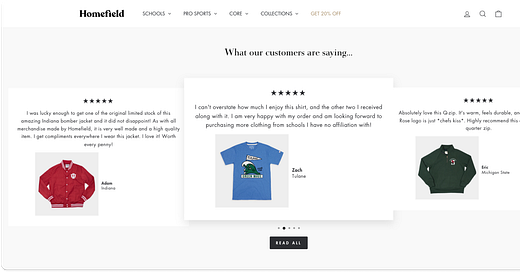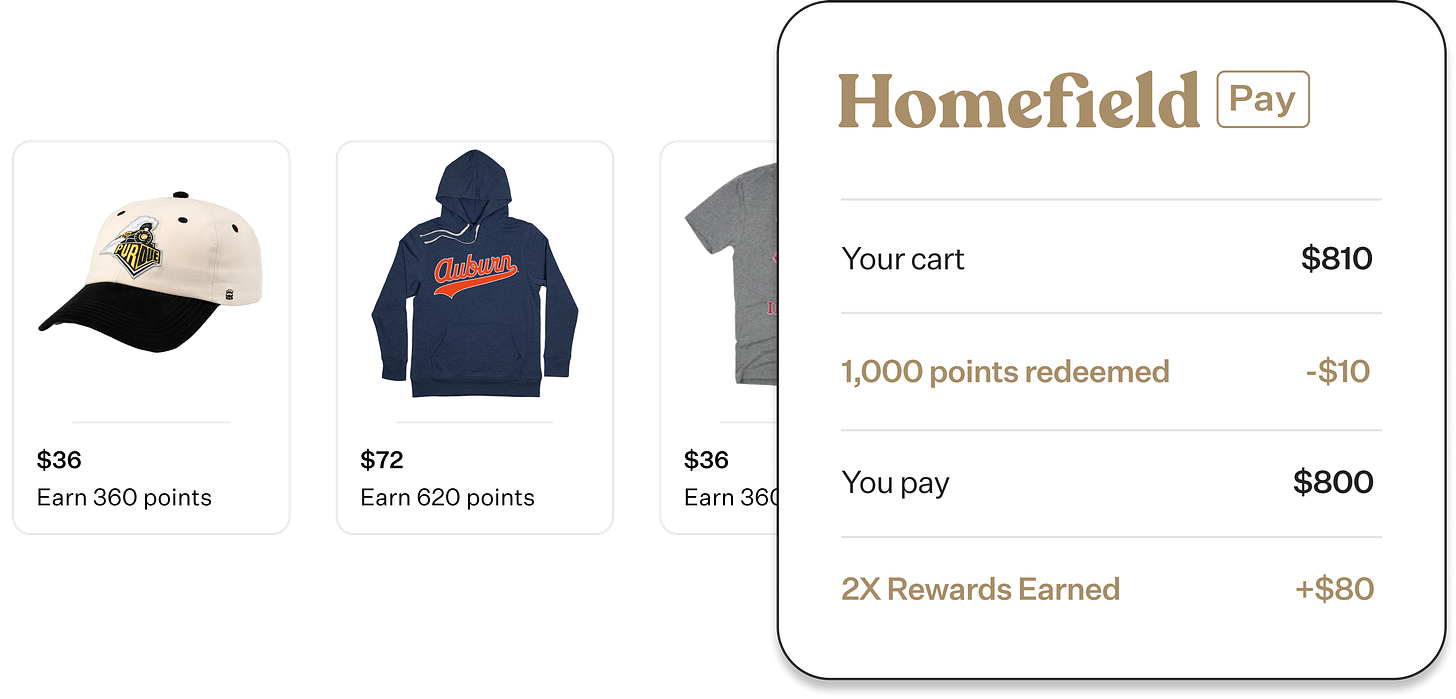The world of college athletics is getting turned upside down thanks to NIL deals, but the one thing that’s not changing is an alumnus’ draw to their alma mater’s retro logos and mascots. Nostalgia’s a powerful thing.
Connor Hitchcock has tapped into that advantage with Homefield, a premium college apparel brand that focuses on vintage designs for more than 180 schools. As Connor puts it, Homefield “allows you to show you’re part of a community while standing out from the crowd.”
And while that may be true, Homefield stands out from the crowd, too.
A few weeks ago, we noticed Connor and his team had invested pretty heavily in their retention stack over the last 12 months, creating a loyalty program and launching an app at roughly the same time.
Given the reviews on the homepage, we figured there was a larger strategy at play.
What we learned in our Q&A with Connor, though, was that he’s flipped the investments in his funnel, putting more effort and energy into reinforcing loyalty than most brands do at his stage. Read on below
One of the things we noticed was that you invested pretty heavily in your retention stack, if you will, last year. Brought on a loyalty program and launched an app at the same time.
It seems like they must have been linked in terms of decision making. Were they? If so, what was the impetus for that?
It was a part of a broader push to ensure we owned the means of communicating to our customers and we had less distance between ourselves and them.
Despite having spent a ton of money on ads at a previous job, I really pushed back against the need to spend a ton on Meta—we do spend on Meta, but it is a single digit percentage of our revenue—and I would so much rather take the longer term, 10-20-year view of exponential math of referrals.
So that was the decision of … you know … reward our current customers, who are great advocates for the brand, and make it even better for them to buy from us, but also make it more enticing for them to refer others. And, in that way, we are building a runway for ourselves in the future that is even less dependent on ad spend.
And so that was that decision. In tandem with the app, which we wanted to improve load times, we have a direct means of communication with you if you're on the app, because we can send push notifications.
Do these programs get measured against contribution dollars? Incremental margin? How do you weigh success here?
Because of the longterm timeline we're operating on, we measure success more directionally.
There aren't necessary hard number - and maybe we should be more dialed in—but I'll look at the app as “are people adopting the app in line with or at greater rates than our growth?” and then from a referral standpoint, yes, there are referral numbers we want to hit, but, really, it's more in post-purchase survey data. Our number one channel is friends and family, and I want that number as a percentage to increase directionally every year, because that’s durability, right?
Homefield, in particular, has to deal with licensing fees. So, when you talk about contribution margin, in my mind, contribution margin not only includes marketing spend but the royalty rate as well, meaning I ultimately have less to spend on marketing.
So, if I can turn my customers into my marketing arm, that’s much better.
If we step back on the business for a minute, you didn’t raise a seed round until after being strongly in market for several years. How’s that company history impact your decisions? How’s it found its way into your brand?
This year will be our first profitable year. We’ve been building up to this moment, but because we needed the headcount and infrastructure to get to this.
We raised money to spend on marketing, but moreso on marketing headcount than direct spend. We have a team that can be very creative in terms of marketing and how to create value and create repeat purchases and create referrals.
I've always had the guiding principle to build the business toward profitability, but with the fundamentals of what we do, we had to reach a certain scale, even if our unit economics were good. You just had to reach a certain scale before you even got to a positive range. So, that's this year.
When raising, we took a non-traditional route where, for a while, we just went back to the well with angels for five years at infrequent intervals, but when we took on our first VC money last year, it took a long time, because I wanted to find a partner that understood I wasn't going to go 3X year over year and I was going to aim for profitability.
You recently built branded payments into the app, and have plans to add it to your loyalty program. How are you thinking about that against the backdrop of why you brought on those programs to begin with?
It's just making the deal sweeter for our customers, right?
One of the ways I think about it is how can I make it a better experience for someone to buy from Homefield? If I can do that, the more likely they are to buy more, and the more likely they are to getting closer to that line of telling their friend about it, right?
And that can set up a chain reaction of two people who both tell two people who both tell two people, right? In that case, I've not marketed to two people, I've marketed to eight people, right?
So that's where it is for me, spending on the front end to make a better customer experience, rewarding them more so that they go tell people.
Interested in taking a deeper look at your own retention strategy?
Tandym works with brands to evaluate their existing program, gauge the effectiveness of the program, tweak the spend, and improve efficiency. Said in fewer words: we help you spend less on a better program.
Get in touch below to learn more, and check out Homefield Pay as an example of how we’ve integrated Branded Payments into a pre-existing, high powered loyalty program.






